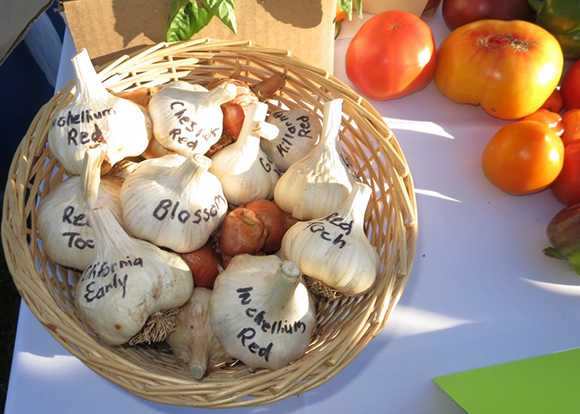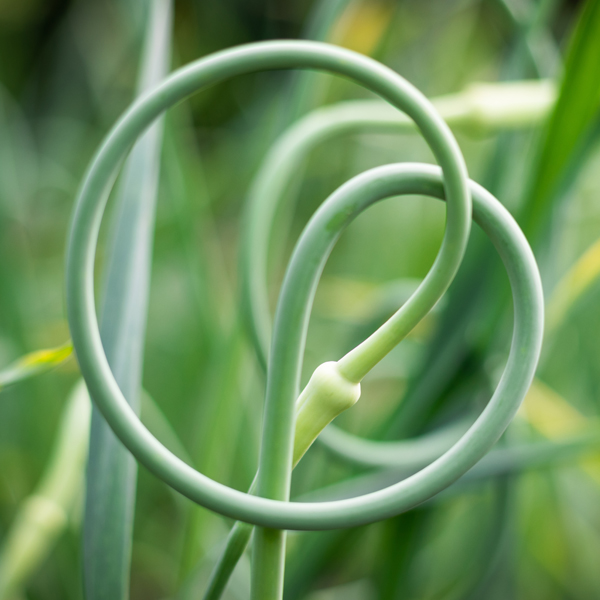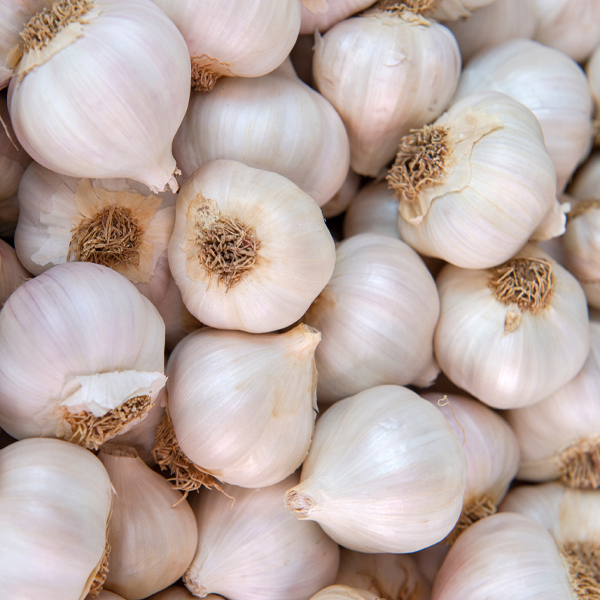
Find a host of garlic cultivars for your garden online.
Garlic is a member of the genus Allium, which includes chives, onions, shallots, and leeks. It’s an underground bulb (also called a head) made up of 8 or 20 cloves depending on the variety. There are many different garlic cultivars, but the soil, water, location, climate, and other factors can influence their flavor and the color of their papery wrapping. Elephant garlic, found in stores and garden catalogs, is not a true garlic, but a type of bulbing leek.
Snap off curly scapes in spring and use as you would use garlic cloves in your cooking.

Hard-neck vs. Soft-neck
Garlic generally falls into two categories: hard-neck and soft-neck. Soft-neck garlic is named for its soft stem. It’s sometimes called silver-skin garlic in a nod to its white papery wrapping. This is the garlic that you’ll most often find in food stores. Each soft-neck head has 6 to 18 cloves packed in several layers and the heads have a long shelf life after harvest.
Hard-neck garlic (Allium sativum ssp. ophioscorodon) produces heads with 5 to 10 large cloves that grow in a single circle around a central woody stem. The cloves range in flavor from mild to strong and spicy. Hard-neck garlic is very cold-tolerant but has a short shelf life once harvested.
Hard-neck garlic also produces a stiff flowering stalk, called a scape, topped with bulbils (tiny bulbs) instead of seeds. Chopped and tossed into a stir-fry dish, the scapes add a hint of garlic flavor and aroma. You can purée the scapes for pesto and use them on pasta.
Planting
Choose a spot with six or more hours of full sun from spring through summer. Plant the cloves in fertile, well-drained soil, placing them 3 to 4 inches apart and 2 to 4 inches deep. Keep the cloves watered during dry weather in fall and again in spring and summer. Dry soil results in smaller heads of garlic.
After planting the cloves this month, they’ll send up a few leaves while they send down the first roots. The first hard freeze usually kills the young leaves but they’ll reappear in March or April. When the weather warms in spring, feed the plants with a nitrogen-rich fertilizer, fish emulsion, or manure tea once a week between regular watering.
Harvesting
The scapes appear in late spring. Snap them off with your fingers when the stalk is young and curly and about a foot long. By summer, the leaves begin to turn yellow and fall over—a sign the garlic is dry and ready for harvest. When the leaves start to yellow, stop watering the plants. In the Chicago area, harvest time is usually in July.
Use a spading fork to loosen the soil around the outer edge of the rows. If you try pulling the bulbs out of the ground instead of digging them out, the leaves will break off. Brush the soil from the bulbs and roots but don’t wash them. Dry the heads for about a month in a cool shady place with low humidity and good air movement.
For best flavor, don't refrigerate garlic.

Storing
Freshly harvested heads of garlic contain cloves that are moist and have a mild flavor. The cloves eventually become dry and their flavor intensifies to a spicy-peppery zing, and they send up a green shoot that can be very bitter, especially when raw. When that happens, cut the cloves in half and remove the green shoot.
Don’t refrigerate garlic, but do store it in a cool area where there is some air circulation. A kitchen countertop is likely a better choice than inside a cabinet or pantry.
Nina Koziol is a garden writer and horticulturist who lives and gardens in Palos Park, Illinois.


